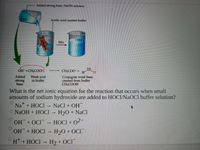
Chemistry
10th Edition
ISBN: 9781305957404
Author: Steven S. Zumdahl, Susan A. Zumdahl, Donald J. DeCoste
Publisher: Cengage Learning
expand_more
expand_more
format_list_bulleted
Concept explainers
Question
thumb_up100%

Transcribed Image Text:Added strong base: NaOH solution
OH
Acetic acid/acetate buffer
N-7
Mix
OH +CH;COOH
CH;COO" +
H
Added
Weak acid
in buffer
cak base
strong
base
Conjugate
created from buffer
CH.COOH
What is the net ionic equation for the reaction that occurs when small
amounts of sodium hydroxide are added to HOCI/NAOCI buffer solution?
Na + HOCI
O NAOH + HOCI
NaCl + OH™
H2O + NaCl
OH+ OCI
HOCI + 02-
OH +HOCI
H2O + OCI"
H + HOCI
H2 + OC
Expert Solution
This question has been solved!
Explore an expertly crafted, step-by-step solution for a thorough understanding of key concepts.
Step by stepSolved in 2 steps

Knowledge Booster
Learn more about
Need a deep-dive on the concept behind this application? Look no further. Learn more about this topic, chemistry and related others by exploring similar questions and additional content below.Similar questions
- Which pair of substances cannot be combined to form a buffer solution in water? Group of answer choices NaHSO4 and Na2SO4 HCl and KCl HF and LiF ascorbic acid (HC6H7O6) and sodium ascorbate (NaC6H7O6)arrow_forwardWhich of the following combinations could not be used to make an effective buffer? O HNO2 and NaNO2 O NH,Cl and NH3 O CH,CO,H and NaCH,CO2 O NaHSO3 and NazSO4arrow_forwardWhich of the following solutions is a good buffer system? A solution that is 0.10 M HC2H3O2 and 0.10 M LiC2H3O2 A solution that is 0.10 M HF and 0.10 M NaC2H3O2 + A solution that is 0.10 M HCl and 0.10 M NH A solution that is 0.10 M NaOH and 0.10 M KOH None of the above are buffer systems.arrow_forward
- Which of the following aqueous solutions are good buffer systems? 0.10 M nitrous acid + 0.13 M sodium nitrite 0.31 M ammonium bromide + 0.31 M ammonia 0.29 M hydroiodic acid + 0.23 M potassium iodide 0.16 M potassium fluoride + 0.21 M hydrofluoric acid O 0.39 M acetic acid + 0.25 M potassium acetatearrow_forwardWhich of the following aqueous solutions are good buffer systems? O0.13 M hypochlorous acid + 0.12 M sodium hypochlorite O 0.10 M potassium fluoride + 0.30 M hydrofluoric acid 0.27 M hydrobromic acid + 0.23 M potassium bromide 0.39 M acetic acid + 0.28 M potassium acetate O 0.34 M ammonium nitrate + 0.38 M ammoniaarrow_forwardThe net ionic equation for the reaction occurring when a small amount of sodium hydroxide solution is added to a buffer solution containing NH4Cl and NH3 is correctly shown here: NaOH + NH --> NH3 + H₂O + Na+ True Falsearrow_forward
- What is one of the products formed when potassium hydroxide and hydrochloric acid are used in titration? hydrogen gas free oxygen water O potassium oxide What are needed to form an ammonium hydroxide solution?* O NO2 and H20 N2 and H20 O NH3 and H20 O NO2 and dilute NaOHarrow_forwardqarrow_forwardDetermine if the following salt is neutral, acidic or basic. If acidic or basic, write the appropriate equilibrium equation for the acid or base that exists when the salt is dissolved in aqueous solution. If neutral, simply write only NR. CSHSNHI 04- D2+ 3+ 4+ 1 2 4 5 7 9 3 Os (s) (1) (g) (aq) + OH- NR H H3O+ C H2O Reset • x H2O Delete CO LOarrow_forward
- Which of the following aqueous solutions are good buffer systems? O 0.34 M ammonium nitrate + 0.31 M ammonia O 0.20 M sodium hydroxide + 0.23 M sodium chloride O 0.37 M hydrofluoric acid + 0.25 M sodium fluoride O 0.17 M nitrous acid + 0.11 M sodium nitrite O 0.21 M perchloric acid + 0.17 M sodium perchloratearrow_forwardWhich of the following aqueous solutions are good buffer systems? 0.18 M barium hydroxide + 0.22 M barium bromide O0.11 M acetic acid + 0.19 M hydrobromic acid 0.33 M sodium perchlorate + 0.25 M calcium perchlorate O 0.28 M hydrochloric acid + 0.20 M sodium chloride 0.30 M ammonia + 0.37 M ammonium bromidearrow_forwardWhat is the function of indicator in a titration? Edit View Insert Format Tools Table 12pt ✓ Paragraph BIU IU AT²V 2 T² : Carrow_forward
arrow_back_ios
SEE MORE QUESTIONS
arrow_forward_ios
Recommended textbooks for you
 ChemistryChemistryISBN:9781305957404Author:Steven S. Zumdahl, Susan A. Zumdahl, Donald J. DeCostePublisher:Cengage Learning
ChemistryChemistryISBN:9781305957404Author:Steven S. Zumdahl, Susan A. Zumdahl, Donald J. DeCostePublisher:Cengage Learning ChemistryChemistryISBN:9781259911156Author:Raymond Chang Dr., Jason Overby ProfessorPublisher:McGraw-Hill Education
ChemistryChemistryISBN:9781259911156Author:Raymond Chang Dr., Jason Overby ProfessorPublisher:McGraw-Hill Education Principles of Instrumental AnalysisChemistryISBN:9781305577213Author:Douglas A. Skoog, F. James Holler, Stanley R. CrouchPublisher:Cengage Learning
Principles of Instrumental AnalysisChemistryISBN:9781305577213Author:Douglas A. Skoog, F. James Holler, Stanley R. CrouchPublisher:Cengage Learning Organic ChemistryChemistryISBN:9780078021558Author:Janice Gorzynski Smith Dr.Publisher:McGraw-Hill Education
Organic ChemistryChemistryISBN:9780078021558Author:Janice Gorzynski Smith Dr.Publisher:McGraw-Hill Education Chemistry: Principles and ReactionsChemistryISBN:9781305079373Author:William L. Masterton, Cecile N. HurleyPublisher:Cengage Learning
Chemistry: Principles and ReactionsChemistryISBN:9781305079373Author:William L. Masterton, Cecile N. HurleyPublisher:Cengage Learning Elementary Principles of Chemical Processes, Bind...ChemistryISBN:9781118431221Author:Richard M. Felder, Ronald W. Rousseau, Lisa G. BullardPublisher:WILEY
Elementary Principles of Chemical Processes, Bind...ChemistryISBN:9781118431221Author:Richard M. Felder, Ronald W. Rousseau, Lisa G. BullardPublisher:WILEY

Chemistry
Chemistry
ISBN:9781305957404
Author:Steven S. Zumdahl, Susan A. Zumdahl, Donald J. DeCoste
Publisher:Cengage Learning

Chemistry
Chemistry
ISBN:9781259911156
Author:Raymond Chang Dr., Jason Overby Professor
Publisher:McGraw-Hill Education

Principles of Instrumental Analysis
Chemistry
ISBN:9781305577213
Author:Douglas A. Skoog, F. James Holler, Stanley R. Crouch
Publisher:Cengage Learning

Organic Chemistry
Chemistry
ISBN:9780078021558
Author:Janice Gorzynski Smith Dr.
Publisher:McGraw-Hill Education

Chemistry: Principles and Reactions
Chemistry
ISBN:9781305079373
Author:William L. Masterton, Cecile N. Hurley
Publisher:Cengage Learning

Elementary Principles of Chemical Processes, Bind...
Chemistry
ISBN:9781118431221
Author:Richard M. Felder, Ronald W. Rousseau, Lisa G. Bullard
Publisher:WILEY